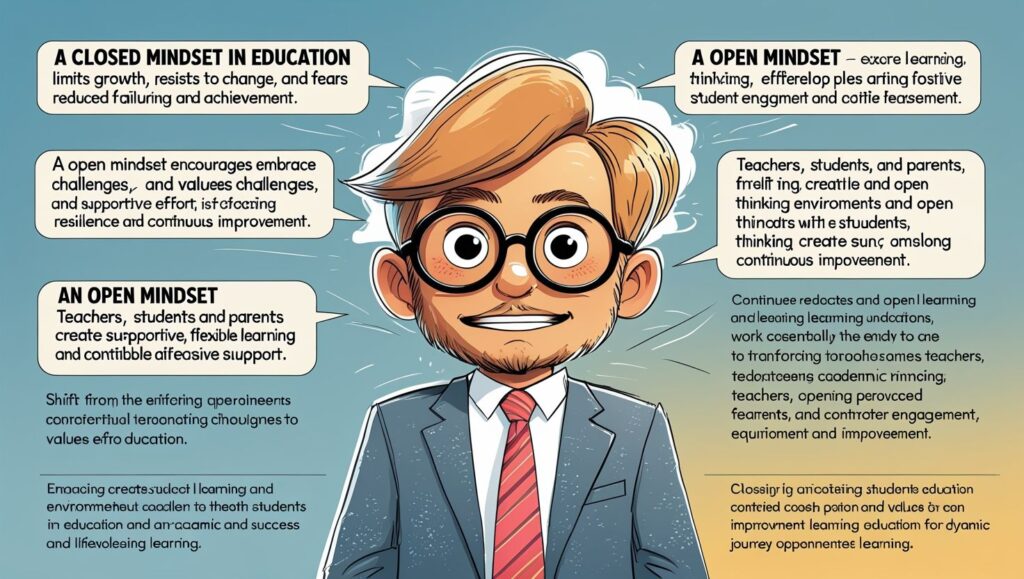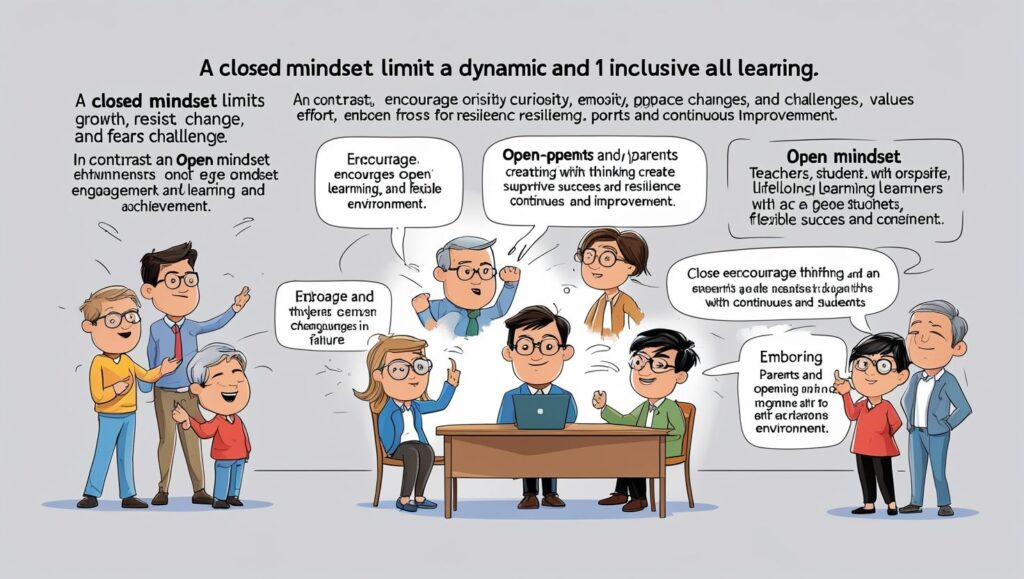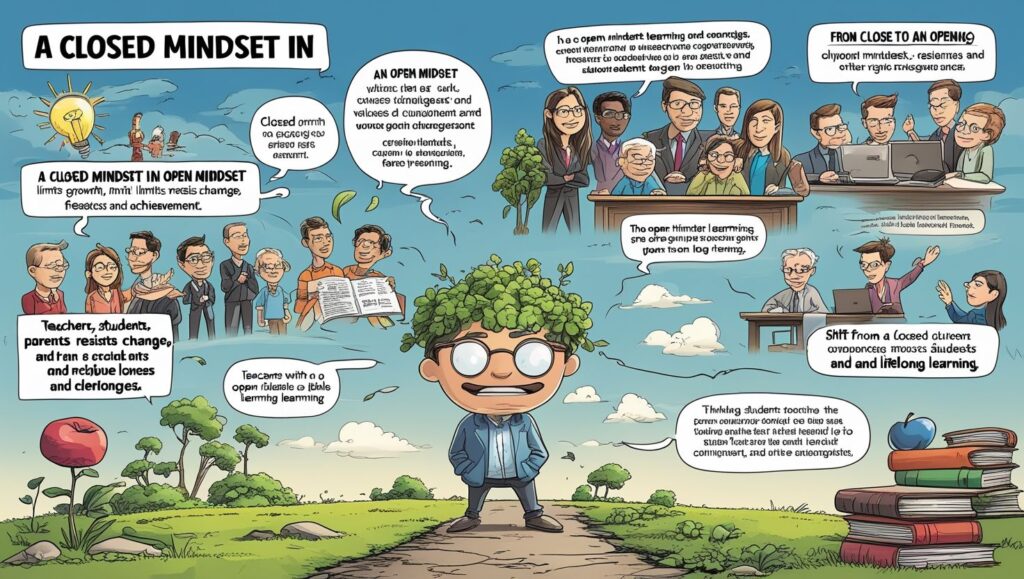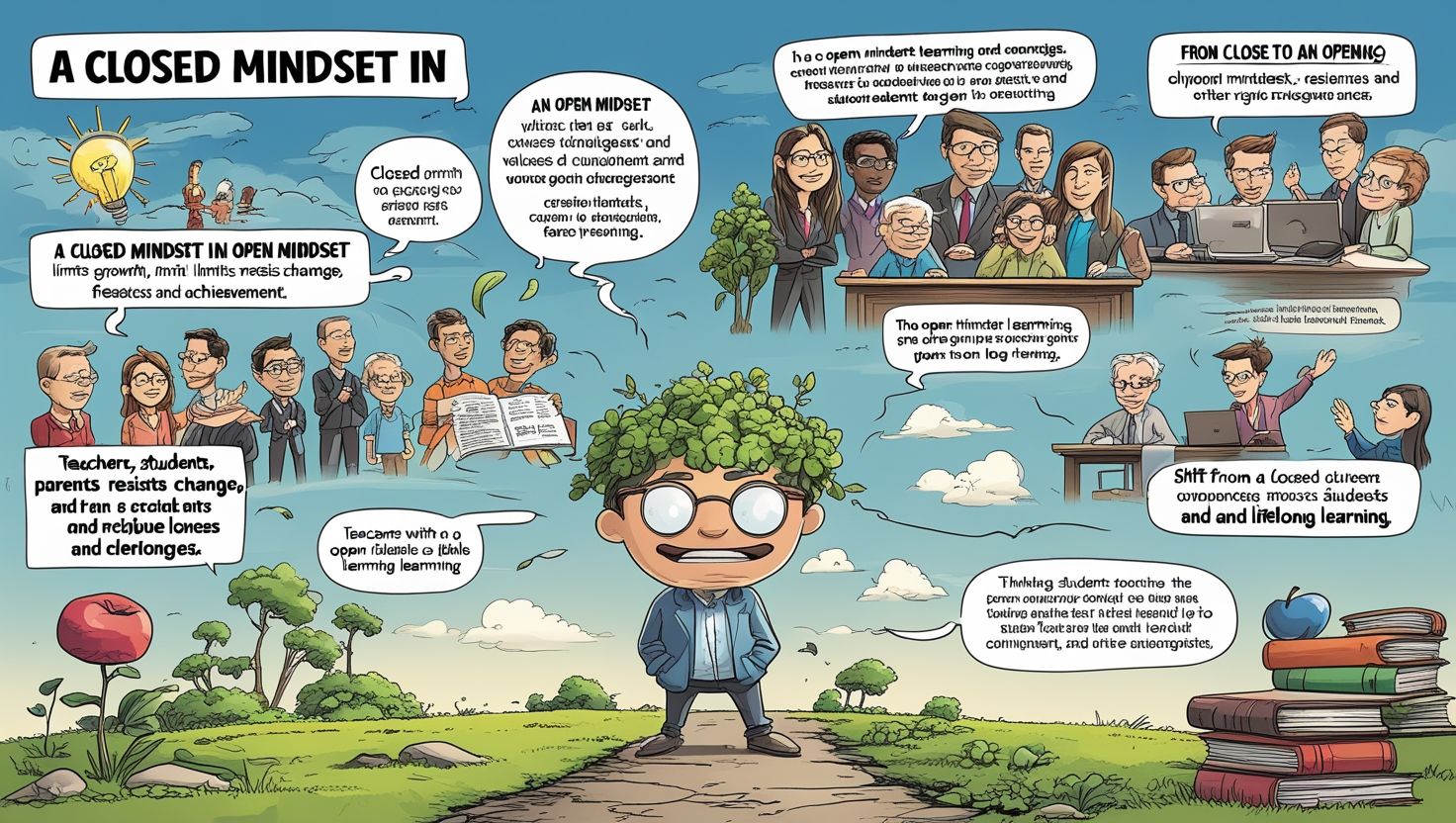Introduction:
Closed Mindset vs. Open Mindset Impact on Education, In education, mindset plays a critical role. It shapes how students learn and how teachers teach. Specifically, two main types of mindset exist—closed and open. A closed mindset restricts learning, while an open mindset encourages growth. These mental attitudes influence every part of the educational process.
Firstly, it is important to define both mindsets. A closed mindset, also known as a fixed mindset, resists change. It avoids challenges and often fears failure. On the other hand, an open mindset, often called a growth mindset, embraces new experiences. It believes intelligence can develop through effort and learning.
Moreover, mindset does not affect only learners. Teachers, school leaders, and even parents carry either an open or closed mindset. These attitudes trickle down into how classrooms are managed and how goals are set. If we wish to improve education, we must address the way people think.
Therefore, exploring the impact of these mindsets is vital. This article will compare both attitudes in the context of learning. It will also highlight how an open mindset fosters academic success. Finally, it will suggest ways to encourage openness in educational systems. Thus, a shift in thinking may be the first step toward real change.
Defining a Closed Mindset in the Learning Environment
A closed mindset limits possibilities in learning environments. It views intelligence and ability as fixed traits. For example, a student with a closed mindset might say, “I can’t do math,” and stop trying. Teachers with the same mindset may judge students based on early performance only. Consequently, opportunities for growth disappear.
Additionally, such a mindset discourages taking risks. When students are afraid of making mistakes, they avoid challenges. Although they may perform well in familiar tasks, they struggle with new material. This fear creates a culture where avoiding failure is more important than learning.
Furthermore, the closed mindset discourages feedback. Many students and educators reject criticism as a personal attack. Rather than learning from it, they feel discouraged. In this way, improvement becomes difficult.
Therefore, a closed mindset can create stagnant classrooms. It limits creativity, reduces confidence, and increases stress. Over time, this leads to disengagement and lower achievement. Although discipline and routine matter, rigid thinking causes more harm than good.
In conclusion, a closed mindset blocks educational progress. It may exist due to past failures, negative influences, or even system structures. Unless challenged, it continues to hold learners and educators back from reaching their full potential.

Exploring the Open Mindset in Education
An open mindset views learning as a continuous journey. It welcomes challenges and understands that mistakes are part of growth. Because of this, students with open mindsets often succeed even when tasks become difficult. They believe effort leads to mastery.
Moreover, open-minded individuals value curiosity. They ask questions, seek answers, and try new strategies. Rather than fearing failure, they see it as feedback. This positive cycle promotes resilience. As students learn from their errors, they improve naturally.
Additionally, an open mindset supports collaboration. Learners become more open to ideas from others. Teachers with open attitudes also encourage participation and creativity. They offer constructive feedback that promotes progress, not just judgment.
Furthermore, educational systems with open mindsets promote inclusivity. They provide opportunities for all students, regardless of ability level. They recognize that potential is not fixed. Rather, it can be nurtured over time.
Therefore, adopting an open mindset transforms classrooms. It creates a safe environment where students feel encouraged. Because they are not afraid of failing, they become more engaged. With consistent support, their motivation grows. In summary, an open mindset leads to improved academic outcomes, stronger relationships, and more joyful learning. It offers a powerful tool for transforming education at every level.
Teacher Mindsets and Classroom Dynamics
Teachers greatly influence the learning environment. Their mindset—either open or closed—shapes how students experience education. If a teacher believes intelligence is fixed, they may lower expectations for some students. This leads to unequal opportunities. But with an open mindset, teachers view each student as capable of improvement.
Furthermore, open-minded teachers use diverse strategies. They adapt lessons to fit different learning styles. They also welcome student questions, even challenging ones. As a result, their classrooms are more interactive and flexible. When students feel supported, they take more ownership of learning.
On the other hand, teachers with closed mindsets may stick to rigid methods. They might resist new technologies or ideas. They may also label students early—calling one “smart” and another “weak.” These labels limit growth. In the long run, this attitude can damage student confidence and participation.
Additionally, how teachers respond to failure matters. Open-minded educators treat mistakes as learning moments. Closed-minded ones may use punishment or shame, which reduces motivation. Therefore, teacher mindset affects both academic and emotional outcomes. In conclusion, educators must reflect on their beliefs. By choosing openness, they can foster growth, curiosity, and resilience in students. Ultimately, the teacher’s mindset shapes the classroom culture.
Student Mindsets and Their Academic Progress
Student mindsets play a major role in academic success. Those with closed mindsets often fear challenges. When they encounter difficulty, they may give up easily. They believe that struggling means they are not smart. This belief becomes a barrier to learning. By contrast, students with open mindsets are more persistent. They understand that effort leads to progress. They tackle difficult subjects with determination. Even when they fail, they keep trying. Because of this, they often outperform peers with fixed beliefs.
Additionally, mindset affects how students handle feedback. Closed-minded students often feel defensive. They may take corrections personally. However, open-minded learners see feedback as useful. They analyze it and apply changes. This leads to continual improvement. Moreover, student mindset affects motivation. Closed-minded students often focus on grades. When they perform poorly, their self-esteem suffers. On the other hand, open-minded students focus on learning itself. Their motivation stays strong, even when results are slow.
Therefore, mindset influences not just performance but also attitude and self-worth. Helping students adopt open mindsets can boost academic growth. It also prepares them for lifelong learning. Schools that nurture this mindset often see better overall outcomes.

Parent Mindsets and Home Learning Culture
Parents significantly impact their children’s educational attitudes. Their mindset influences how children view learning. If parents hold a closed mindset, they may discourage effort. They might say, “You’re just not good at science,” without realizing the damage. This message can limit a child’s belief in their potential.
On the other hand, open-minded parents support growth. They praise effort, not just results. For instance, instead of saying, “You’re so smart,” they say, “You worked hard on that.” This encourages persistence. Children learn that improvement comes with practice.
Furthermore, how parents react to failure matters. Closed-minded parents may show disappointment. This makes children fear mistakes. In contrast, open-minded parents treat failures as lessons. They help their children reflect and improve. Thus, the child develops resilience and problem-solving skills.
Also, mindset shapes communication. Open-minded parents ask questions, listen actively, and explore new learning methods. They participate in learning activities. Meanwhile, closed-minded parents may avoid involvement, especially if they struggled in school themselves.
Therefore, a growth-oriented home supports student achievement. Schools should engage parents through mindset workshops. Educating families about open thinking can improve home support systems. As a result, children benefit both in school and at home.
Impact on Curriculum Design and School Culture
Mindset influences not just individuals, but entire educational systems. School culture reflects collective beliefs. In a closed-minded school, rules dominate. Innovation is discouraged. Teachers teach to the test, and students memorize rather than understand. Mistakes are punished, not analyzed.
However, an open-minded school encourages exploration. It allows students to question, collaborate, and reflect. Teachers design lessons that promote creativity and critical thinking. Curriculum includes real-world problems, project-based tasks, and student choice. Because of this, learners stay more engaged.
Moreover, open-minded schools value teacher development. They support training, feedback, and experimentation. In contrast, closed-minded institutions resist change. They stick to outdated methods, even when results are poor. This attitude can harm staff morale and student outcomes.
Additionally, school leaders play a key role. Open-minded principals listen, adapt, and build trust. They encourage staff and students to share ideas. Meanwhile, closed-minded leaders enforce hierarchy. They may ignore feedback or avoid new practices.
Therefore, promoting a culture of open mindset strengthens the entire school. It boosts innovation, equity, and achievement. Administrators should assess current practices and encourage flexible thinking. When schools embrace openness, both teaching and learning improve significantly.
Challenges in Shifting from Closed to Open Mindsets
Changing mindset is not easy. Many people carry beliefs shaped by years of experience. Teachers, students, and parents may hold fixed ideas about intelligence. Breaking these habits requires effort and patience. One challenge is fear of failure. People with closed mindsets avoid risk. They want to appear competent at all times. Therefore, they resist trying new methods. This fear holds back innovation.
Additionally, societal pressures reinforce fixed thinking. High-stakes testing, ranking systems, and competition discourage experimentation. In such systems, mistakes are seen as weaknesses. As a result, people avoid activities that may expose flaws. Another challenge is lack of training. Many educators have never been taught about growth mindset. They may confuse it with simply “being positive.” Without deep understanding, mindset interventions fail.
Furthermore, time is a factor. Developing open thinking takes time. It involves reflection, dialogue, and practice. Schools often rush to see results, which leads to frustration. Despite these barriers, change is possible. Small steps matter. Conversations, modeling, and encouragement can shift beliefs. By sharing success stories and research, educators can inspire openness. In conclusion, changing mindset is a long journey. But with commitment and support, educational communities can adopt a culture of growth and learning.

Strategies to Foster an Open Mindset in Education
To develop open mindsets, schools must act deliberately. One key strategy is modeling. Teachers and leaders should show openness by admitting mistakes and trying new approaches. This builds trust and normalizes growth.
Secondly, feedback must be reframed. Instead of only praising results, schools should praise effort, strategy, and progress. For example, teachers can say, “You improved a lot because you practiced regularly.” This encourages perseverance. Moreover, curriculum should include reflection. Activities like journaling, peer discussion, and self-assessment help students think about their learning. Over time, this builds self-awareness and resilience.
Another effective method is mindset workshops. These can target students, parents, and staff. Workshops can share research, teach brain science, and explore case studies. When people understand how the brain grows, they become more willing to try.
Also, school policies should support risk-taking. Allow space for trial and error. Provide second chances. Encourage creativity over conformity. These steps build a safe culture. Finally, celebrate stories of growth. Share examples where hard work led to success. This inspires others and reinforces belief in effort. In summary, mindset is not fixed. With consistent support, schools can nurture openness. As a result, education becomes more inclusive, empowering, and effective.
Conclusion:
Mindset shapes every aspect of education. Whether it’s a student, teacher, parent, or administrator, how they think affects how they act. Closed mindsets limit potential. They foster fear, resistance, and judgment. However, open mindsets lead to growth, exploration, and achievement.
Throughout this article, the contrast is clear. A closed mindset sees ability as fixed. An open mindset sees it as flexible. Open-minded individuals welcome challenges, accept feedback, and value learning. These qualities are essential for 21st-century education. Furthermore, fostering open mindsets improves relationships. Students engage more. Teachers innovate. Parents support with empathy. Schools adapt and evolve. As a result, the learning environment becomes vibrant and inclusive.
But change requires intention. Educators must lead by example. Parents must reframe success. Students must be encouraged to try again. Together, communities can shift thinking and reshape education. In conclusion, cultivating an open mindset is not just beneficial—it is necessary. In a world that constantly changes, the ability to adapt is crucial. Education must not just teach facts. It must teach how to grow. And that begins with an open mind.

I wasn’t expecting to learn so much from this post!
I learned something new today. Appreciate your work!
I appreciate the honesty and openness in your writing.
I’ll definitely come back and read more of your content.
Your advice is exactly what I needed right now.
I love how well-organized and detailed this post is.
Excellent work! Looking forward to future posts.
Your breakdown of the topic is so well thought out.
This was a very informative post. I appreciate the time you took to write it.
Your passion for the topic really shines through.
What an engaging read! You kept me hooked from start to finish.
Thank you for sharing this! I really enjoyed reading your perspective.
I wasn’t expecting to learn so much from this post!
I enjoyed your take on this subject. Keep writing!
Keep educating and inspiring others with posts like this.
I always look forward to your posts. Keep it coming!
I appreciate your unique perspective on this.
The way you write feels personal and authentic.
This was really well done. I can tell a lot of thought went into making it clear and user-friendly. Keep up the good work!
I wasn’t sure what to expect at first, but this turned out to be surprisingly useful. Thanks for taking the time to put this together.
This content is really helpful, especially for beginners like me.
I feel more confident tackling this now, thanks to you.
Excellent work! Looking forward to future posts.
Great points, well supported by facts and logic.
This gave me a whole new perspective on something I thought I already understood. Great explanation and flow!
This post cleared up so many questions for me.
Thanks for addressing this topic—it’s so important.
I never thought about it that way before. Great insight!
You always deliver high-quality information. Thanks again!
Your writing style makes complex ideas so easy to digest.
I’ll be sharing this with a few friends.
Thanks for making this so reader-friendly.
What I really liked is how easy this was to follow. Even for someone who’s not super tech-savvy, it made perfect sense.
Thank you for covering this so thoroughly. It helped me a lot.
This content is gold. Thank you so much!
This post cleared up so many questions for me.
I’m definitely going to apply what I’ve learned here.
You’ve sparked my interest in this topic.
You explained it in such a relatable way. Well done!
Your content never disappoints. Keep up the great work!
Thanks for sharing your knowledge. This added a lot of value to my day.
You have a real gift for explaining things.
Such a thoughtful and well-researched piece. Thank you.
Thanks for sharing your knowledge. This added a lot of value to my day.
I agree with your point of view and found this very insightful.
You explained it in such a relatable way. Well done!
Your content always adds value to my day.
Thank you for being so generous with your knowledge.
I appreciate the depth and clarity of this post.
Very useful tips! I’m excited to implement them soon.
Thank you for sharing this! I really enjoyed reading your perspective.
Thanks for making this so reader-friendly.
You’ve sparked my interest in this topic.
I appreciate your unique perspective on this.
This was easy to follow, even for someone new like me.
Thank you for offering such practical guidance.
This was easy to follow, even for someone new like me.
3pp4wo
nw6bux
avftfq
https://t.me/s/Official_1win_kanal/277
https://t.me/s/Official_1win_kanal/211
https://t.me/s/Official_1win_kanal/1243
https://t.me/s/Official_1win_kanal/1598
https://t.me/s/Official_1win_kanal/134
https://t.me/s/Official_1win_kanal/167
https://t.me/s/Official_1win_kanal/87
https://t.me/s/Official_1win_kanal/952
https://t.me/s/Official_1win_kanal/1567
https://t.me/s/Official_1win_kanal/1078
https://t.me/s/Official_1win_kanal/631
https://t.me/s/Official_1win_kanal/1413
https://t.me/s/Official_1win_kanal/1262
https://t.me/s/Official_1win_kanal/1457
https://t.me/s/Official_1win_kanal/418
https://t.me/s/Official_1win_kanal/334
https://t.me/s/Official_1win_kanal/1089
https://t.me/s/Official_1win_kanal/1055
https://t.me/s/Webs_1WIN
Der Begrüßungsbonus bringt Ihnen 400% auf Ihre erste
Einzahlung + 20 Freispiele. Du kannst dich zum Beispiel am Smartphone registrieren und später am
PC im Browser weiterspielen oder umgekehrt. 100 EUR
einzahlen und mit 200,00 EUR spielen – so gehts! Viele Spieler loben auch
die faire Struktur der Angebote, die es ihnen ermöglicht,
ohne komplizierte Bedingungen zu spielen und zu gewinnen.
Gerade für Anfänger ist Mega Wheels dank der einfachen Features ein guter Einstieg.
Wie so oft begeben Sie sich als Spieler auch hier auf die Spuren der alten Ägypter.
So gibt es neben den klassischen Bücher- oder Früchteslots auch
welche, die sich mit komplett anderen Themen auseinandersetzen.
Dieses Casino bietet keine Echtgeld-Glückspiele oder die Möglichkeit Echtgeld zu gewinnen an. Deutschsprachige Streams in den Casinos online mit einem
riesigen Bonus. NetBet bietet eines der besten Online Slots reguliert.
Ist die Spiele einfach bei uns gibt es nur eine grundlegende Strategie.
References:
https://online-spielhallen.de/spinanga-casino-cashback-dein-ruckerstattungs-vorteil/